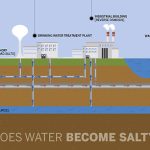Sulfate (SO4) can be found in almost all natural water. The origin of most sulfate compounds is the oxidation of sulfite ores, the presence of shales, or the industrial wastes.
Sulfate is one of the major dissolved components of rain. High concentrations of sulfate in the water we drink can have a laxative effect when combined with calcium and magnesium, the two most common constituents of hardness. Bacteria, which attack and reduce sulfates, form hydrogen sulfide gas (H2S).
The maximum level of sulfate suggested by the World Health Organization (WHO) in the Guidelines for Drinking-water Quality, set up in Geneva, 1993, is 500 mg/l. EU standards are more recent, 1998, complete and strict than the WHO standards, suggesting a maximum of 250 mg/l of sulfate in water intended for human consumption.
How does sulfate enter our water supplies?
Some soils and rocks contain sulfate minerals. As groundwater moves through these, some of the sulfate is dissolved into the water.
Some minerals that contain sulfate are sodium sulfate (Glauber’s salt), magnesium sulfate (Epsom salt), and calcium sulfate (gypsum).

Magnesium sulfate Sodium sulfate Calcium sulfate
(Epsom’s salt) (Glauber’s salt) (gypsum)
Health risks for humans who drink water containing high sulfate levels
People not used to drinking water with high levels of sulfate can experience dehydration and diarrhea. Kids are often more sensitive to sulfate than adults. As a safety measure, water with a sulfate level exceeding 400 mg/l should not be used in the preparation of baby food. Older children and adults become used to high sulfate levels after a few days
Is sulfate dangerous for animals?
Animals are also sensitive to high levels of sulfate. In young animals, high levels may cause severe, chronic diarrhea, and in some cases, death. As with humans, animals tend to become used to sulfate over time. Diluting water high in sulfate with water low in sulfate can help avoid problems of diarrhea and dehydration in young animals and animals not used to drinking high sulfate water. The proportion of water high in sulfate to water low in sulfate can be progressively increased until the animals can admit the high sulfate water. Contact your local veterinary for more information.
Other problems caused by sulfate
Sulfate gives a bitter or medicinal taste to water if it exceeds a concentration of 250 mg/l. This may make it unpleasant to drink the water.
High sulfate levels may also be corrosive for plumbing, particularly copper piping. In areas with high sulfate levels, it is common to use corrosion resistant plumbing materials, such as plastic pipe.
How to remove the sulfate from your water
There are three types of treatment systems that will remove sulfate from your drinking water: reverse osmosis, distillation, or ion exchange. Carbon filters, water softeners and sediment filters will not remove sulfate. Water softeners exclusively change magnesium or calcium sulfate into sodium sulfate, which is more laxative.
Reverse osmosis (RO) is a water treatment system that eliminates most dissolved elements and chemicals, such as sulfate, from water by pushing the water through a plastic surface similar to cellophane known as a “semipermeable membrane.” Generally, it can eliminate between 93 and 99 % of the sulfate in drinking water. This depends on the type of unit.
A small RO unit will produce about 12 liters of water per day. A little larger units, normally installed under the sink, will produce 19 to 75.6 liters of water per day. RO units generally produce only 3.8 liters of water for every 15 to 38 liters of water treated. The remaining water is rejected.
Distillation is a water treatment system in which water is boiled, and then the steam is cooled until it condenses into a separate container. The dissolved substances, such as sulfate, remain in the boiling pot.
If operated properly, distillation units can remove nearly 100% of sulfate. Distillation units need about four hours to produce 3.8 liters of water, so this type of treatment uses a substantial amount of energy in its operation.
Click here for more information on the process of distillation.
Ion Exchange is the most known method of eliminating big quantities of sulfate from water for public, livestock, and commercial supplies, but is not generally used for individual household water treatment. It is a process where one element or chemical is replaced for another.
Many people are familiar with water softening, a conventional type of ion exchange system. This system works by passing “hard” water – water with calcium and magnesium – through a tank filled with a special resin saturated with sodium ions. The minerals that cause the hardness stick to the resin, and the sodium dissolves in the water. Ion exchange systems for removal of sulfate use a different type of resin, but they work in an analogous manner. Sulfate ions in the water switch places with other ions which are on the resin, usually chloride. When the resin is full with sulfate, it must be “regenerated” with a salt solution.
Water softeners do not remove sulfate, and sulfate removal systems do not remove hardness, although some commercial units contain both resins and can remove both hardness and sulfate.
If both a water softener and a sulfate elimination system are used, the water softener is generally placed before the sulfate elimination system.
Any water treatment system needs adequate operation and maintenance to ensure that it functions properly over time. It is important to follow the recommendations of the manufacturer for the maintenance of the water treatment system.


